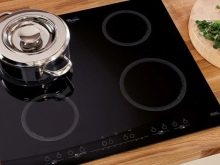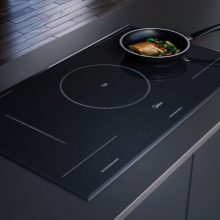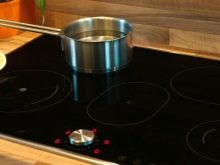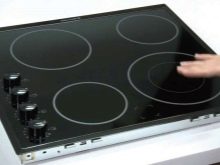Features and operation of touch electric plates

From time immemorial, the stove has been an integral part of every kitchen. Most modern stoves operate on gas or from the mains, but sooner or later any model may fail and there will be a need to replace it. Choosing a new thing, we always strive for a better, more improved version. So, the induction oven with touch control is replacing the traditional cookers. But how to use it correctly - very few people know. More about the features of operation.



What it is?
The new generation electric stove is a device that heats dishes by creating a magnetic field. In addition to the aesthetically pleasing "shell", the unit includes a control IC board, a temperature sensor and a voltage regulator. There are three types of touchpads.
- Freestanding touch plate with oven. The body is made mainly of enameled metal or stainless steel, the hob itself is made of tempered glass or glass ceramics.
- Tabletop model resembles traditional electric stoves, looks like an electronic scale. This is an irreplaceable option for summer cottages, business trips or temporary trips.
- Built-in hob inverter type for 2-4 burners. The advantage of the model is that under it you can place what is more convenient for the owner: storage boxes, oven, microwave oven, dishwasher or other electrical appliances.



Externally, the touch plate is not much different from an electric oven with a ceramic panel and electronic control. However, the principle of their operation is completely different: an electric furnace heats up with the help of built-in heating elements, and an inverter one works due to the influence of an electromagnetic field.
Advantages and disadvantages
The main difference between an induction hob with touch control is the absence of the usual mechanical type switches. The programs and functions of the cooker are activated by simply touching the corresponding value on the panel with your finger. This option has the following advantages:
- ease of use;
- high quality;
- high speed of heating and cooling;
- wide potential;
- energy saving;
- aesthetically pleasing design;
- high functionality;
- ease of care;
- no soot;
- comparative safety.


The disadvantages of an induction cooker include the fact that the device requires certain skills to use, it has a limited shelf life and a high price. In addition, glass ceramics is a rather fragile material.


Characteristic
Ease of care is the main feature of touch models. Unlike hotplates, an induction oven is much easier to clean. It is not necessary to remove the grilles and switches, as well as to clean the burnt layer. After each cooking, simply wipe the panel with a damp cloth or sponge. Controlling such a stove does not require much effort. You can turn on the desired function or set a specific mode with a simple touch.
Built-in sensors on the panel identify the width of the bottom of the cookware. Thanks to this, the heat is evenly distributed around the entire circumference, without rising higher.This heating method allows you to boil the water and complete the cooking process much faster, which saves energy. And also some models are equipped with residual heat indicators for each cooking zone and can control the degree of heating of the dishes.



How do I switch on the smart cooking zones?
An induction hob is a rather complex electrical appliance equipped with various functions and capabilities. The unit is controlled by a touch panel located on the plate. The sensors are so sensitive that the electric stove instantly reacts to the slightest touch. The activation and operation process is carried out as follows:
- pay attention to the panel itself, as a rule, there should be a touch start button - touching this button turns on the plate;
- each individual cooking zone is activated in the same way, and it is also possible to adjust the heating power (from 0 to 9);
- the power modes optimal for a particular operation are described in the operating instructions, which differ from each other depending on the model of the electrical appliance;
- the panel is turned off in two ways - after cooking, you can press the "stop" button or wait a while without putting anything on the stove, the unit will turn off automatically.


Important! The appliance is also equipped with additional functions that allow you to set a panel lock, transfer power from burner to burner, trap heat or turn off the appliance in emergency mode.
Practical tips for use
The instructions for each specific model indicate clear rules for adjusting the heating temperature. When using an inverter oven, it is important to understand that you will not be able to suddenly stop the supply of heat to the cooking zone by turning off the hotplate. To prevent cooked meals from burning, it is best to determine in advance when to reduce the heat. Or the easiest way is to turn off the panel 10 minutes before the end of cooking and leave the dish to simmer on the stove. When turning the stove on and off, as well as when adjusting the power, keep in mind that from just one touch, as the manufacturers say, the mechanism does not have time to work. As a rule, you need to hold your finger on the button for about 5 seconds.
What to do if the inverter cooker suddenly stops working:
- check if the blocking function has been activated;
- pay attention to the power supply network: maybe the electricity was turned off;
- wash your hands, dry them thoroughly, if they are cold, heat them up and try to turn on the oven again;
- by moving another pan to the cooking zone, try switching the oven on again: it is possible that an unsuitable pan is being used.


Care rules
The shelf life of the inverter cooker, set by the manufacturer, is only 15 years, but if handled carelessly, it can be easily shortened. Competent operation of the unit will not only provide a full-fledged period of use, but also extend it.
It is worth paying attention to the basic rules of care.
- Preparation for operation. The new stove must be cleaned of packaging residues, rinsed with soap and salt solution. Otherwise, when you turn on the oven for the first time, there will be a burning smell in the kitchen until the layer of factory grease burns out.
- Purity. Do not leave dirt on the surface. If something spills on the oven while cooking, it's best to wipe it off right away. When stains or food debris dries up, they become more difficult to wipe off and may scratch the surface.
- Cookware should be used with a flat bottom. Curved bottoms can deform the cooking zone, it will heat up unevenly, providing an uneven load on the hob.
- Do not place wet dishes on the stove. It is better to place containers with cold water not on a heated surface. Heating the cookware and its contents evenly will prolong the life of the stove.
- The included stove must always be dry... When the hotplates are in heating mode, do not spill liquid on them so as not to cause a sudden temperature drop. Cracks may form on a fragile panel. The surface can only be washed with the burners turned off.
- An empty hotplate should not remain on at full power. This overloads the heating element and can quickly damage the cooking zone.
- No mechanical damage. Avoid accidentally hitting the surface or dropping objects on it. Glass ceramics or tempered glass are quite fragile materials. Do not hang drying dishes and various household kitchen utensils over the hob.
- The stove is not a storage place. If we are accustomed to the fact that we have a kettle on one of the burners of a gas stove, then this will not work with an inverter stove. Do not store utensils on the glass-ceramic surface, especially those made of low-melting materials. If the oven is accidentally turned on, the dishes can be damaged, and an empty kettle can simply burn out.



Important! If you need to repair the stove, for example, replacing a heating element in the oven or on the surface, only professionals should trust it.
For information on what features are available with touch electric cookers, see the next video.













The comment was sent successfully.